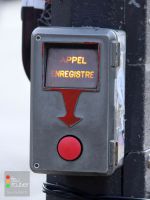
first LED signals



signaux à tubes fluorescents



Technology is advancing in terms of electronic regulation, but also in terms of traffic lights. All Paris traffic lights being incandescent bulbs, arduous maintenance is required by the EDF teams who preventively replace all the bulbs every 6 months.
The arrival of fluorescent tubes in tricolor signaling at the end of the 1970s was to constitute a turning point. Under pressure from EDF, who saw it as an opportunity to make substantial savings, as fluorescent tubes had a considerably longer lifespan than incandescent bulbs, the city of Paris largely equipped its lights with fluorescent sources in the 1980s. This does not go without causing problems, in particular for older generation intersection controllers which will not detect the electrical presence of certain tubes, in particular the controlled red. All Parisian signals without exception will be equipped with fluorescent lights : traffic lights, repeaters, pedestrian signals, and even push buttons.
In the early 1990s, a new light source appeared on the streets of Paris : light-emitting diodes. LEDs will initially be fitted to repeaters and pedestrian signals, their technology and in particular green LEDs not yet allowing them to be used in the main lights (lack of brightness in the green light). They will be generalized from the 2000s.
FIRST LED TRAFFIC LIGHTS

It was in January 1990 that the new central operating station in Paris was set up under rue de Lutèce, but it would not be fully operational until the summer of 1991.
It combines the two operating systems used in Paris at that time:
- SURF 1000: centralized system designed by the CGA (Compagnie Générale d'Automatisme) with HP-1000 F computers constituting the central system and Intel front racks capable of managing a maximum of 720 intersections (there will be approximately 600 in reality)
- SAGE: automatic traffic jam management system, developed by INRETS
The PCE Lutèce was overhauled in 1996, with the arrival of the evolution of the centralized Parisian system SURF 2000.
THE OPENING OF THE P.C.E. LUTECE





SFIM VPE
micro-processor
since 1995
Garbarini Galilée
micro-processor
since1990
Sofrel (Lacroix) Hodos 32
micro-processor
since 1991
NEW 2nd generation MICRO-PROCESSOR CONTROLLERS
SFIM VPZ
micro-processor
since 1978


Garbarini TAG
(Omera OCTM 32)
micro-processor
since 1978
exemplaire conservé au LER

Thomson
micro-processor
since1978
exemplaire conservé au LER
NEW 1st generation MICRO-PROCESSOR CONTROLLERS
incandescent pedestrian priority signal
Théry Hindrick
1990s



Ets Girardin
fluorescent tube
Paris gray or brown color
1990s
NEW PEDESTRIAN PUSH BUTTON


incandescent
and fluorescent tubes
unknown manufacturer
1970s/1980s
LEDs
Ets Girardin
first generation
1990s

incandescent
and fluorescent tubes
Ets Girardin
1990s

Théry Hindrick N.A.
1990s
SIGNAUX SPÉCIAUX
REPEATERS
City of Paris type traffic light manufactured from 1958 to 2004 by Rousseau industrial sheet metal (Robardey group)

thick model
with fluorescent tubes

THE DISAPPEARANCE OF REPEATER VISORS


The first incandescent repeaters and fluorescent tubes designed by manufacturers Girardin and Neuhaus were equipped with metal visors deemed one day dangerous for the safety of pedestrians by an elected Parisian. Although the car repeaters are by definition located on the side opposite the pedestrian crossings, Citélum, then in charge of the maintenance of the Parisian traffic lights, therefore undertook a vast operation to cut these visors, which explains why a good number of Parisian repeaters are lacking.
A simple solution was then found by the manufacturer Girardin who fitted his repeaters with soft plastic visors. Today, this specificity has been retained and the new Grolleau repeaters still have soft rubber visors.
SFIM Ovid beacon and flashing blue Garbarini module


As early as the 1970s, three systems were experimented with to allow RATP buses to have priority when they arrived at a crossroads, but without success.
It was in 1983 that bus priority was relaunched in Paris, jointly between the town hall and the RATP. It is the Ovide system of the manufacturer SFIM which will be retained : each bus of line 26 is equipped with an on-board transmitter responsible for communicating its approach to a receiving beacon fixed to the top of the traffic lights and associated with a flashing blue light triggered when the bus has been detected. 18 intersections located on the route of line 26 will be equipped with it in 1985. This system will then be extended to line 62 in 1987 (25 intersections equipped).
In 1989, the evaluation of these priority bus systems carried out by the city of Paris and the RATP showed that the time savings of the buses were in reality "unquantifiable". This system was finally abandoned in 2003 when the RATP initiated the renewal of the line 26 bus fleet without notifying the city services and without equipping the new buses with a transmitter !... Priority in service on line 62 suffered the same fate in 2007. But it is only in 2013 that bus priority will be deprogrammed at these crossroads, but the beacons are still in place.
Bus priority at junctions will be relaunched with another, more reliable technology from 2001
(see section 2000 > 2010).
BUS PRIORITY EXPERIMENT
signals dating from the 1981 experiment


From 1981, the National Research Institute for Transport and Safety (INRETS) experimented with access control by traffic lights at three accesses to the Paris ring road : Italy, Chatillon and Plaine. The purpose of this experiment was to temporarily stop vehicles entering the ring road during rush hour to allow traffic to flow more smoothly. The equipment used was classic Parisian traffic lights painted green, fixed to the public lighting poles of the tracks and connected to the PC Berlier.
Several temporary experiments took place until 1992, when the device was definitively abandoned because it was totally unsuited to the Parisian context, too subject to the vagaries of traffic causing the ineffectiveness of access control, unlike other places in France where it turned out to be very effective.
However, the traffic lights were never removed and are still in place nearly 30 years after this experiment.
PARIS RING ROAD ACCESS CONTROL
Ets Paul Girardin
1990s


Théry Hindrick N.A. LED
1990s

first LED signals



signaux à tubes fluorescents



Technology is advancing in terms of electronic regulation, but also in terms of traffic lights. All Paris traffic lights being incandescent bulbs, arduous maintenance is required by the EDF teams who preventively replace all the bulbs every 6 months.
The arrival of fluorescent tubes in tricolor signaling at the end of the 1970s was to constitute a turning point. Under pressure from EDF, who saw it as an opportunity to make substantial savings, as fluorescent tubes had a considerably longer lifespan than incandescent bulbs, the city of Paris largely equipped its lights with fluorescent sources in the 1980s. This does not go without causing problems, in particular for older generation intersection controllers which will not detect the electrical presence of certain tubes, in particular the controlled red. All Parisian signals without exception will be equipped with fluorescent lights : traffic lights, repeaters, pedestrian signals, and even push buttons.
In the early 1990s, a new light source appeared on the streets of Paris : light-emitting diodes. LEDs will initially be fitted to repeaters and pedestrian signals, their technology and in particular green LEDs not yet allowing them to be used in the main lights (lack of brightness in the green light). They will be generalized from the 2000s.
FIRST LED TRAFFIC LIGHTS
Silec Astron
Thery Hindrick Ville Nouvelle



Garbarini Design 2000
The technical commission for urban furniture of the city of Paris has always ensured the quality of the elements located on the public highway, but also and above all their aesthetics. It is for this reason that the models of traffic lights have changed very little in Paris, with the exception of the model specially designed for the Champs-Elysées in 1994 (see below).
However, in the 1980s, several experiments with new signals took place in Paris:
- Design 2000 signals from the manufacturer Garbarini at the Tardieu-Invalides crossroads
- Ville Nouvelle signals from the manufacturer Thery Hindrick Quai d'Orsay
- Astron signals from the manufacturer Silec rue du Faubourg St Denis-Gare du Nord
TESTS OF NEW TRAFFIC LIGHTS
Since 1955, a concession agreement linked the city of Paris to EDF, which was responsible for maintaining all public lighting and traffic lights in the capital. In 1987, the city of Paris expresses the wish to break this agreement, too vague, which gave rise to many excesses, EDF being solicited for everything and anything in Paris.
In 1989, after two years of negotiations with other players in the sector, EDF finally signed a new contract with the city of Paris to maintain the maintenance of its lighting and its earthing system. An economic interest group (GIE) will be created with the general water company specifically for the Paris market : GECIR.
To consolidate its position in this sector and separate its activities, in 1993 EDF created a new subsidiary alongside Veolia, Citélum. Citélum will be more and more challenged over the years, maintenance being sometimes chaotic, and its decision-makers allowing themselves to modify the characteristics of certain controllers directly from the manufacturers without notifying the powerful management of roads and travel of the city of Paris.
Citélum will be removed in 2011 when the maintenance contract is renewed (see section 2000 > 2010).
A CONTESTED MAINTENANCE


The avenue and its new traffic lights
In 1994
At the end of the 1980s, the Champs-Elysées were very degraded and a vast renovation was launched in 1990. Work began in 1992 and was completed in 1994. In addition to the redevelopment of roads and sidewalks, a brand new line of street furniture will be created by designer Jean-Michel Wilmotte. This line includes a new model of traffic light named Feux de France. Their manufacture is entrusted to Garbarini.
It is a totem traffic light incorporating a main fluorescent tube light, an LED repeater signal and an LED pedestrian signal. The model will be filed with the INPI by the city of Paris. Today this model is still used on the Champs-Elysées, and has even been implemented in other municipalities.
REDEVELOPMENT OF THE CHAMPS-ÉLYSÉE
NEW PEDESTRIAN SIGNALS
fine model
with incandescent lamps
MODELS OF TRAFFIC LIGHTS
The 1990s was marked by the arrival of light-emitting diodes, commonly called LEDs, in traffic lights.
The total renovation of the Champs-Elysées in 1994 will see the birth of a magnificent model of totem-traffic light specially designed for the most beautiful avenue in the world.
The 1995 inventory shows 9250 traffic lights in service in Paris.
The 1980s were a decade of experimentation in Paris : new models of traffic lights but also experiments in terms of regulation (access control, bus priority, etc.).
EDF will succeed in imposing itself again as maintainer of the Parisian traffic lights, but it will not be without difficulties.
1980 - 1990
Parisian's signals



the website
about
French traffic lights



©2006-2023 | Conception : Hugo MAILLET - all rightd reserved | Companies and brands represented belong to their respective owner